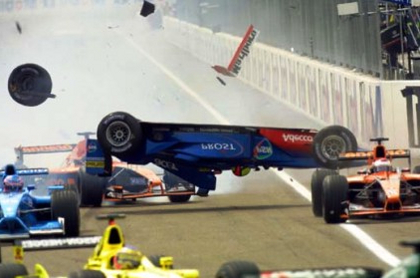Racing Hazards: Formula 1 Dangers and Its Preventive Measures
By Shenron on Dec 12, 2008 with Comments 0
It is not hard to see why Formula One racing can be considered as a dangerous sport. Speeding for over 100 miles per hour throughout the race is an obvious reason. Aside from this, the car design also contributes to the fatalistic possibilities of the said event. Formula One racecars have an open cockpit, which exposes a driver’s body.
Danger can be considered synonymous to F1 racing. What generally set it apart from other professional races are the tracks in which F1 races are held. Usual racetracks have simple oval designs, which allows for gradual turns. In F1 racing, there are sharp left and right turns which are included in the race circuits and each race circuit have different sharp turning points. If the driver did not have sufficient practice on a track prior to a race, it would most probably give him a rather disastrous racing experience.
Given these racetrack conditions, certain measures have been provided to minimize danger and ensure the safety of the race drivers. Racing helmets were designed in the 1970’s and 1980’s and were considered as a very important race accessory due to the car’s open cockpit. Aside from this, a head and neck support system has also been developed to prevent whiplash. Whiplash is the term coined for neck sprains brought about by being thrown either forward or backward at a rapid speed. This kind of injury is most common during F1 races.
Aside from personal safety measures for race drivers, racecars have also been provided with additional safety measures. The cockpit of racecars has been strengthened through the use of strong carbon fiber. This has been utilized to make sure that these compartments would be able to withstand serious accidents.
During an F1 race, track hazards are considered to be the most dangerous elements that can be present inside the racetrack. These track hazards may be in the form of stalled cars, car accidents, and debris. Because of these, flags serve as preventive measures everytime a corresponding color are waved to update the race drivers of the race’s current condition.
Each flag’s color plays a vital role to ensure a smoothly ongoing race. A yellow flag is waved to signal a driver to slow down and that driver is automatically prohibited from over taking another car. A red flag is waved to signal either a temporary or abrupt final end of the race. Meanwhile, a red and yellow striped flag being waved indicates that the track have thus become dangerous due to certain track hazards that have been detected. These are some of the race flags used to keep track of race conditions and prevent major racetrack accidents.
Aside from race flags, a safety car can also be seen during an F1 race. The purpose of the safety car is to keep the pace of the race by leading the race drivers around the track. Safety cars are usually seen when track hazards have been detected and when a car can no longer continue to race and must therefore be moved from the group of ongoing racers.
As dangerous as Formula One racing may be, these safety and preventive measures help ensure that everyone who participates in the said sport would be able to enjoy it throughout the years. It is also important to note that the ongoing modern technological innovations, which helped developed, these measures helped everyone appreciate and focus more on the amazing world of driving and speed.
Filed Under: General
